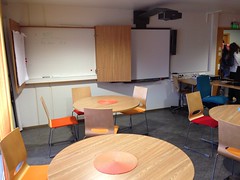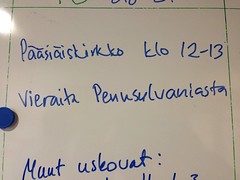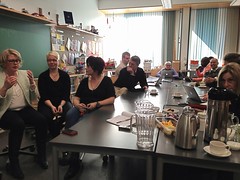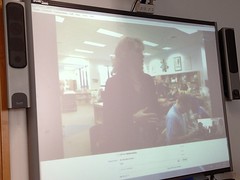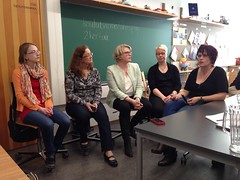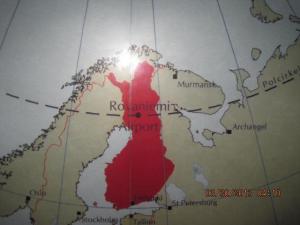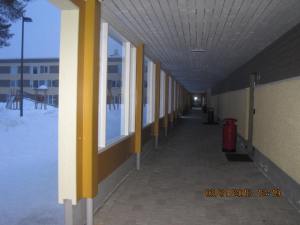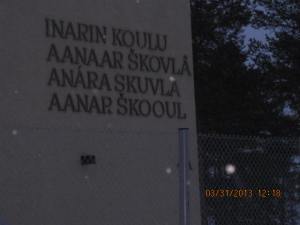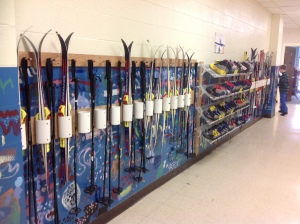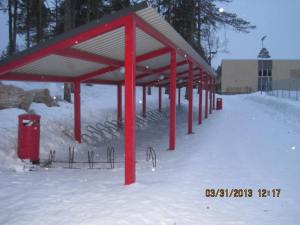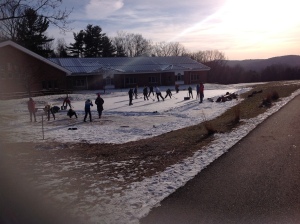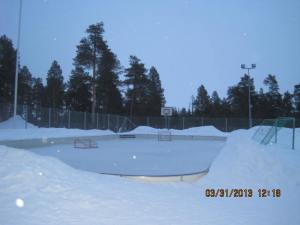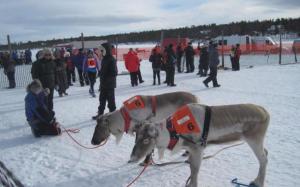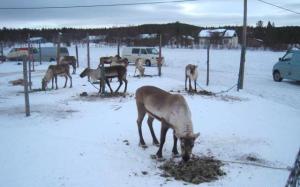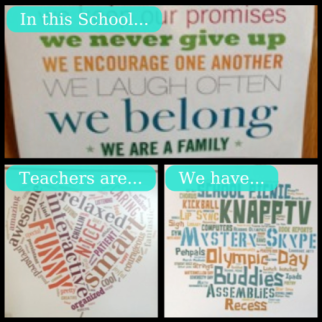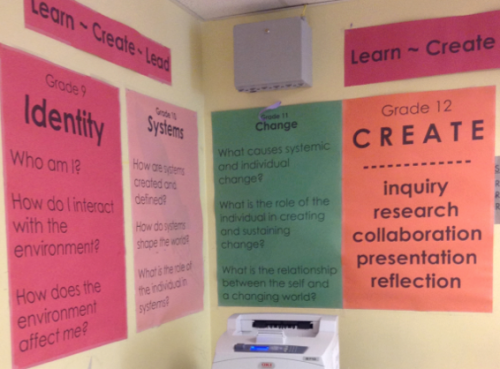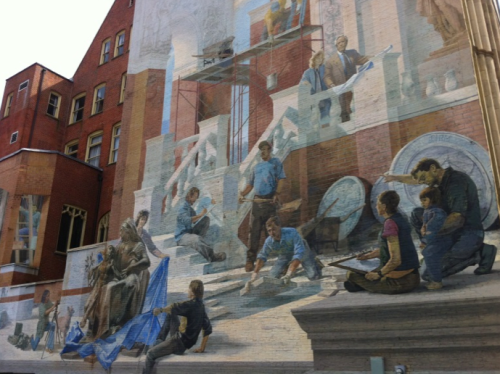Boundless Learning Around the World
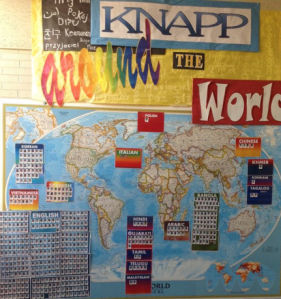 Our visit to Philly was part of Finnable 2020 project (www.finnable.fi) coordinated by Cicero Learning, University of Helsinki. Finnable 2020 fosters boundless learning that break through traditional boundaries about where, when, and with whom learning takes place. Finnable promote the research and design of collaborative, technology enabled learning environments for the 21st century—locally and internationally. These goals rose up in every place we visited.
Our visit to Philly was part of Finnable 2020 project (www.finnable.fi) coordinated by Cicero Learning, University of Helsinki. Finnable 2020 fosters boundless learning that break through traditional boundaries about where, when, and with whom learning takes place. Finnable promote the research and design of collaborative, technology enabled learning environments for the 21st century—locally and internationally. These goals rose up in every place we visited.
Tip of the trip: We suggest that our common next step next fall is “Boundless learning Around the World” – sharing and collaboration in practice with students and adults using technology. What do you think about this? Are you in?
Kati, Minna and Tiina, Koulumestari School/ Learning Center Innokas/ University of Helsinki
Above the Arctic Circle
It has been almost three months since our trip to Finland yet every day I am reminded of the Finnish people, their love of children, belief in education and hope for the future. I want to thank Kati Sormunen, Minna Kukkonen and Tiina Korhonen for their posts this week on PennFinn13. This prompted me to return to my journal and share jottings and lingering reflections. Observing schools earlier this spring, several themes rested between the pages of my notebook.
Back in March after leaving my Pennfinn13 colleagues in Helsinki, I headed to northern Finland with my daughter. Flying into Rovaniemi on the Arctic Circle, we were welcomed by window paintings of a fox on skis,
bears in canoes, reindeer on the airport roof and owls, Arctic tern and polar bears lounging in the center of the baggage claim area. A mannequin Santa greeted us. Clearly this is the real home of Santa Claus (Joulupukki). In town, several men looked like Santa, with a twinkle in their eyes and a long white beard, although none were dressed in a red suit.
 While in Rovaniemi I asked everyone I could about the schools. Did you go to school here? How are the schools? What did you think? Although my sample size was small (eight people) they all shared similar information.
While in Rovaniemi I asked everyone I could about the schools. Did you go to school here? How are the schools? What did you think? Although my sample size was small (eight people) they all shared similar information.
“Yes, the primary schools are very good. You go to the school nearest your home. They are small schools. When you get to the secondary school, the preparation is maybe not as strong as other schools in the south near bigger cities. Sometimes it is hard to find teachers in the rural part of the country. Very few people from Lapland are accepted into the difficult university preparation programs like the one to be a teacher.”
Two adults shared that in Rovaniemi on one side of the river immigrants live who have sought political asylum in Finland. One woman said, “My friend’s parent is the principal of that school and they have some challenges.” She did not elaborate. I spent some time looking through the Rovaniemi and Finland immigration website and discovered there are about 1400 immigrants in this northern city and about 240 arrive each year from the middle east and Africa. There are a multitude of services available. As I read I was impressed with the perspective on welcoming newcomers to a country. I began to think about the multilingual educational approach in Finland and I wondered how this translated to immigrant children in the cities.
When I read the post by Katy, Minna and Tiina about Knapp Elementary, they describe school documents that are translated into many different languages for students and their families. This got me thinking about how in Finland students take exams in various languages. Being able to communicate in your mother tongue is essential to learning.
American writer Teresa McCarty (1993) researched Navajo children where the school is working to maintain the home language and culture. She notes that, “educational, linguistic, and cultural self-determination are inextricably linked” and shows an example of a Native American school that respects the home language and uses this to teach their children, “schools have the potential to silence or give voice to identities rooted and mediated in the local language and culture… no child should be forced to accept … identity at the expense of his or her own” (McCarthy, 1993).
In Lapland, the Sami people live next to individuals who speak Finnish, Swedish and Russian. We were told that Finnish students are able to take matriculating exams in their mother tongue. Depending on where you are in Finland this may be Russian, Swedish, Finnish or Sami. I wonder how educators in Finland embrace multilingualism beyond the European languages. For immigrants to Finland, I think it will be challenging for schools to maintain current educational beliefs and practices as the country embraces a more diverse population. As all countries become a global citizenry acceptance and change will necessitate new thinking. The Finnish have it correct — where children take a test in their mother tongue. If there are immigrants who speak multiple languages, the greater the diversity of languages, the more difficult it will be to make accommodations to the various languages.
I enjoyed learning about the language, food, cultural events and resource centers of the Sami people in Lapland. Three residents with whom I spoke talked about how the small rural schools only go to a certain grade and then students on the outskirts of the city have to travel far to attend their secondary or vocational education. Some people travel from Inari to Rovaniemi. The rural nature of northern Finland poses some interesting challenges.
What do these rural schools look like? We rented a car, left Rovaniemi and travelled to a more rural part of Lapland. As we drove I stopped to take photos of Koulu (Schools) enroute. I noticed a few things. We were there over the Easter holiday break so I was only able to peek in the windows and observe the outside of the school. First, they all had outdoor hockey rinks, and outdoor ski and bike racks which were lit up at night. One had a wood fired heating plant just outside the school, similar to the ones in Vermont. In Vermont we store our skis inside the school and use them as part of our physical education class. In Finland in three rural schools I visited there were skis stored outside the school ready for their next use. Residents shared that students skied to school.
Being on the Arctic circle for a month it is totally dark so one resident explained that the lights stay on. In the spring there is a little more natural sunlight, but at dusk the lights automatically turn on, illuminating the bike racks and bike paths. Yes, they put studded tires on their bicycles, children ride to school, in the dark, in the light, in the snow, all year long,
There were winter outdoor playgrounds and igloos made by the children. A teenager shared that all children are allowed to go outside to play in the very cold, they just wear more clothing. Eric Barker, the Nordic ski coach at Mt. Mansfield Union High School has said to me many times that there is no such thing as bad weather, just bad clothing. Thinking about these schools, and the igloo, I was reminded of several times in Vermont when children are prohibited from going outside for fresh air in the winter when it is “too cold.” Perhaps in the United States we are a bit afraid of the cold. Why? I got the sense that the Finns felt they should embrace the cold as it was simply a part of life.
Whether talking about accepting and adapting to the cold weather, or accepting and adapting to a child’s mother language, as educators we must all try to move beyond what we have been taught. We must adapt to our environment and the people whom we serve in the environment. In doing so, we will find more success for our children and future generations.
Reference: McCarty, T. L. (2002). What if the children forget the Navajo language? A place to be Navajo: Rough Rock and the struggle for self-determination in indigenous schooling (pp. 179-191), Mahwah. NJ: Lawrence Erlbaum.
The Sun Sets Slowly in Lapland
 Recalling our trip this past March, I left our PennFinn13 group and headed north with my daughter. We rented a car and drove about four hours northeast of Rovaniemi, Finland to Inari. One would never know we were above the Arctic circle as the roads were in better condition than many roads back in Vermont on the 45th parallel. I wondered about the difference between hoar frost, permafrost and frost heaves. Thinking about the general construction and engineering of the roads, I figured I’d better leave this topic for another day. Suffice it to say we did not hit one frost heave. In addition to being great educators, the Finns seem to understand road engineering.
Recalling our trip this past March, I left our PennFinn13 group and headed north with my daughter. We rented a car and drove about four hours northeast of Rovaniemi, Finland to Inari. One would never know we were above the Arctic circle as the roads were in better condition than many roads back in Vermont on the 45th parallel. I wondered about the difference between hoar frost, permafrost and frost heaves. Thinking about the general construction and engineering of the roads, I figured I’d better leave this topic for another day. Suffice it to say we did not hit one frost heave. In addition to being great educators, the Finns seem to understand road engineering.
My daughter and I learned about the Kings Cup, a championship reindeer racing event. We wanted to watch the Sami athletes on skis being pulled behind reindeer. We stayed in a small cabin at a campsite with simple bunks, rented some skis and from then on skied everywhere. On the first day in Inari we met Carol Brown Leonardi, a British woman who had worked at the University of Rovaniemi, but was now at the Open University in Cambridge, UK. Her current research brought her to Inari studying the Sami people and local economy. With shivering hands and a notebook, she interviewed us about the impetus for our vacation and our thoughts about tourism and other general impressions. I asked her if she wanted to borrow my small hand held tape recorder. She was delighted by the idea so we skied back to the cabin and I bought her my tape recorder, the same one with sound bytes from my research from the schools in Helsinki. She put away her notepad. A day later I met her at the local hotel so she could download the sound flies to her computer.
The Kings Cup is a yearly event where the reindeer herders provide jockeys to compete against each other in sprints, relay races and a longer loop out on the ice. The jockeys are dressed in sleek Nordic or alpine racing suits. Some race on Nordic skis, some on alpine and one competitor chose telemark skis. The race organizers piled up snow to make a packed path lined with small branches on Inarijarvi (Lake Inari). Next to the course were booths with reindeer sausage and all manner of animal pelts, hats, jackets, and other sundry. The reindeer were corralled in a makeshift paddock on the side of the race course.
Over the course of the weekend, everyone laughed, smiled and wore lots of festive clothing. It was cold. The races themselves were spectacular. Reindeer are not large animals, but as they raced by their large tongues lolled and they gracefully sprinted. Once past the finish line they were corralled to their area and fed fresh clumps of lichen.
During the relay races, one competitor would complete a lap, release the reins, ski over and tag the next member of the team and the next reindeer would be released from the start chutes. Some of the reindeer had a mind of their own and chose to trot across the ice and ignore the actual course. When another reindeer entered the vicinity the stubborn wayward reindeer would then gear up to race again, bursting onto the course to compete with the others. The crowds consisted of tourists and locals. The children at the Kings Cup wandered about, laughing and playing in the snow, free to be part of the festivities. There were no parents training them or barking commands, but all adults had a watchful eye and would gently redirect a child now and again.
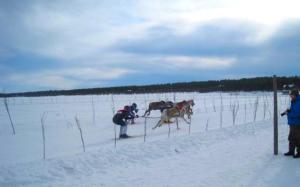 There was broadband everywhere (A constitutional right for the people of Finland). After my daughter negotiated the price of some reindeer pelts, we got ready to pay and the Sami man took from his breast pocket a credit card wifi swipe unit, punched in the price, took my money and we were done. We strapped the pelts to our backpacks and headed out across the lake back to our cabin.
There was broadband everywhere (A constitutional right for the people of Finland). After my daughter negotiated the price of some reindeer pelts, we got ready to pay and the Sami man took from his breast pocket a credit card wifi swipe unit, punched in the price, took my money and we were done. We strapped the pelts to our backpacks and headed out across the lake back to our cabin.
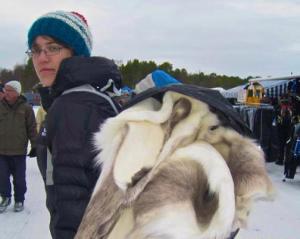 One difference between my home and Finland is it takes forever for the sun to set when you are on the Arctic Circle. In Vermont if you are at the summit of Camel’s Hump or Mt. Mansfield, you bundle up, feel the wind whipping over the 4,000 foot peak, sit down and wait for nature’s show. The sky lights up, orange red and yellow hues, then the sun sinks over Giant Mountain in the Adirondacks, it is over in about 20 minutes. In Lapland this takes about three hours. Think about it — the northern latitude and the rotating earth. With our reindeer pelts we skied out onto the lake which went forever. We kept going and then decided we ought to turn back, skiing into the sun we watched for a long time as the giant yellow orb slowly lowered itself to the horizon.
One difference between my home and Finland is it takes forever for the sun to set when you are on the Arctic Circle. In Vermont if you are at the summit of Camel’s Hump or Mt. Mansfield, you bundle up, feel the wind whipping over the 4,000 foot peak, sit down and wait for nature’s show. The sky lights up, orange red and yellow hues, then the sun sinks over Giant Mountain in the Adirondacks, it is over in about 20 minutes. In Lapland this takes about three hours. Think about it — the northern latitude and the rotating earth. With our reindeer pelts we skied out onto the lake which went forever. We kept going and then decided we ought to turn back, skiing into the sun we watched for a long time as the giant yellow orb slowly lowered itself to the horizon.
I am so very appreciative of all the Finnish educators who made our trip possible and to the PennFinn13 leader Joe Mazza and teammates. The reflections, insights, ideas and inspirations, like the sunset on Inarijärvi, linger on and on. I am not sure it will ever be completely gone, as the red glow occupies a little space in my heart for the beautiful people of Finland.
In this school we are a family – Visiting Knapp Elementary School
In the beginning of our visit to Knapp Elementary School outside of Philadelphia, the Principal Joe Mazza welcomed all students, personnel and us visitors to begin the new school day through central radio. The announcement included birthday wishes to all having birthday at a current day and because of becoming vacation, birthdays on summertime were also mentioned. Students were involved in the announcement and in the end of it they said their pledge to the day: “I am a smart, special, valuable person. I respect my self and I respect others. My words are kind and honest. I accept only my best in all I do. I am PROUD to be me!”
We began our school tour in the concert made by the school orchestra. They surprised us by playing our national anthem “Maamme”. What an awesome moment! It was really a pleasure to meet all the students and answer their questions. We were happy to tell them some cultural and other information about Finland and were asking the questions about their schooling. They were happy to hear about the possibilities to peer collaboration next fall with Finnish students.
After the school tour Knapp leadership teams shared comprehensive efforts on the part of the school teams. Teachers in Knapp may choose their team in the beginning of the term and there are approximately 7-9 teachers in a team. Sounds very familiar to us: we have same kind of shared leadership and teamwork idea also in Koulumestari School in Espoo. Sharing more specifically these practices and experiences could be very rewarding in the future.
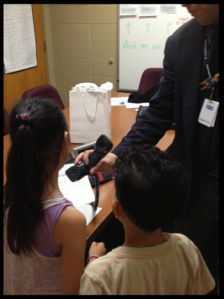
In Knapp they use social media and web based tools to share the information needed. As the school is multicultural having about 22 languages spoken in the students’ homes, they have translated the most important information at their website into all languages by using Google translator. Also various other home school partnership practices was highlighted. This is also our common goal – developing home, school and community partnership and practices and the use of technology in this collaboration.

Warm thanks to Knapp personnel, students and parents! It was great to meet you and feel the family-like atmosphere at your school.
Tip of the day: How about recycling your children’s books? At Knapp they had a bookshelf where you can bring your old book and take a “new” with you.
Minna, Kati and Tiina, Koulumestari School/Learning Center Innokas, University of Helsinki
Caring for youngsters – A Visit to Science Leadership Academy (SLA)
Our school, Koulumestari is a normal Finnish elementary school, where we focus on child-centered teaching strategies, inquiry, project-based learning and the use of technology.
It was wonderful to pay a visit to the school, SLA, which shares the same thinking. Science Leadership Academy (SLA) is a public high school. It is a 1:1 project-based laptop school where all students and teachers use computers as a learning tool. There are a lot of similarities between our school and SLA and we would like to share a few examples of these practices with other educators. We think that the practices can be employed both with young kids as well as with older students. Internship At SLA, an internship is part of a student’s personalized learning plan. During their internship, 10th and 11th grade students work 2 hours per week every Wednesday in a place they have chosen together with their teacher. A few of the students interned at SLA as senior assistant teachers, one student described her job as an assistant in the medical museum. Experiences of these whole year internships were introduced to others as “capstone” presentations. During their internship year, a student can see if their intern job is something for them in the future. At Koulumestari school we have a similar practice, with the 4th, 5th and 6th grade students applying for an internship for a day. They apply for a job at the nearby library, day care center, the school kitchen, the school janitor’s or at the school as a tutor. After their work day they write and publish a blog entry about their day. Personal responsibility A key practice we observed at SLA was the development of self-image and self-regulation skills. On every grade the students’ reflection is guided by a few core questions (pictured below). Posted on the walls, the questions are present in every school day.
Every person working in the building has access to every room. Students can spend their break in the teachers’ lounge and principal Chris Lehmann’s door is open for students, teachers or guests to pop in for a chat. The school presents a warm and caring atmosphere. Self-regulation skills are present also at Koulumestari School, on every grade level. We use various practices in order to encourage students in exploring themselves: Who am I? What are my strengths? We also use a lot of self-evaluation and goal-setting. During the past few years we have created learning places for students in and around the school. If a student has earned their teachers’ trust, they can choose their preferred learning place. You can come across students working in the sofa group in the lunchroom as well as at tables in the hallway. It was great to notice so many similarities and get tips and new ideas during our visit.
Tip of the day: “If I want the teachers to take care of students I have to take care of teachers” (Chris Lehman, Principal/SLA)
Kati Sormunen, Minna Kukkonen and Tiina Korhonen, Koulumestari School / Learning Center Innokas/ University of Helsinki
Know the Neighborhood You Teach In
This week, Finnish educators from Koulumestari Elementary and Helsingin normaalilyseo (Normal School) are here visiting US schools, as well as learning about teacher/leader education programs at the University of Pennsylvania as part of our #pennfinn13 partnership. Below is the first post after today’s visit to Penn’s Graduate School of Education.
Visit to Penn GSE
In April we had visitors from University of Pennsylvania. They were trying to figure out what is special in Finnish school system. This week we have an opportunity to visit Philadelphia and meet some old friends and get to know new acquaintances. Goal of our visit is to find new ideas and create collaboration between Universities and schools. A very important issue is to collaborate in a practical student to student peer level.
Today we paid a visit to University of Pennsylvania. We met enthusiastic professionals that have same kind on ideologies that we do. There was one thing above all that we want to bring back to Finland with us. When you start your job as a teacher in a new area, you should get to know the neighborhood of that school. What kids do after school? Where and how they spend their free time? What is it like to be a kid today in area? How about students as experts making a tour in school neighborhoods with their new teacher? While getting familiar with each other a good idea is to discuss about the expectations vice versa.
Tip of the day: Knowing one’s surroundings, its culture and history, makes you commit to your own neighborhood. See http://muralarts.org/
Kati Sormunen, Minna Kukkonen and Tiina Korhonen www.innokas.fi/en
For more in Koulumestari Elementary School in Finland check out these links.
Finland: The Lighthouse of Progressive Education and Divergent Learning
By Kavan Yee
It has been a number of weeks since my trip to Helsinki. In this time, I’ve had many opportunities to go over my observations of the Finnish school system. As I spoke more and more often about their pedagogy, I could not help but think about David Kolb’s Learning Styles Model and his Experiential Learning Theory. Tweet after tweet, blog after blog you can read of all the #pennfinn13 examples of how our Finnish counterparts put Kolb’s theories into practice. From the teachers, administrators, and students we spoke to, it resonated with me that the commitment to understanding the whole-student was an integral piece to development of the type of learners (or the type of citizens) they want to be. This was quite apparent to me when I visited Helsingin Suomalainen Yhteiskoulu (SYK) and noticed that one of the school’s core values was: “Learning by Doing”. At another school–Innokas Koulumestari–creating innovators is the goal where technology is purposefully integrated with team teaching to support the differentiation of their students. Vice Head Tiina Korhonen believes that “mobile learning is and should be personalized for everyone.” Kolb states that the divergent learner “likes to gather information and observe everything around him. Because of these traits, the learner is viewed as someone who is creative, open-minded, respectful of other people’s perspective, and has a greater awareness of the perceived affordance.”
It is from these examples, I am confident to believe that the principles of the Finnish education system are based upon the promotion of progressive values to create divergent and innovative learners. The true success of this system is not their PISA scores–high stakes testing of facts and statistics is not the goal. Their true success is to create educated citizens–a population that is curious, innovative, creative, open minded, and respectful. Friends, isn’t this the purpose of any educational system? The creation of life-long learners? A community that wants to help each other by solving problems and learning more?
In a previous blog, I questioned if the progressive model translates in the Finnish system– I believe it does. In a conversation I had with Pasi Sahlberg, Director of the Finnish Ministry of Education Centers for International Mobility, he agreed: “If John Dewey was alive today, he would see his words on child-centered and problem-based learning put into practice in Finland.”
Understanding the Whole Child and The Importance of Building a School Community
At SYK, every student in the upper secondary school is placed with an advisor. The advisor and the advisory class “loop” together each year until the student graduates from the school. The advisor acts as the liaison between the parent and the school, monitoring the student’s academic, social, and emotional welfare. The advisory class acts as a microcosm to the larger school universe. To help develop personal introspection and leadership, a Big Brother/Big Sister Program was installed to help with the mentoring of younger students in the primary school. The program begins in 7th grade when a student is paired with a 3rd grader. The relationship grows as the students advance each year together until the mentor graduates from the school. The mentee then becomes the mentor for another 3rd grader, completing the cycle to build a stronger and closer community. “It is so nice to see them grow and mature over time. It’s cool to see them in the hallways and they become your biggest supporters during your last year and at graduation.” – Maria Puolakkainen, 17 year old student at SYK
Development of experiential, hands-on, problem-based units that promote skills in communication and collaboration
“Learning is a process whereby knowledge is created through transformation of experience.” (Kolb, 1984, p.38). I saw examples of problem-based learning in all of the schools we visited. As a Science Curriculum Coordinator, one lesson in particular stood out for me. Calculus students at SYK learn the meaning of knowledge application by finding the volume of an oil spill–using the chain rule and determining the change in the radius with respect to time. Students were asked to question and teach their classmates on how to find solutions to the problem using a document camera.
In the hallways, student work was hung to exhibit the integration of thematic-based units: easels of oil painted cell structures, 3D bird models that show adaptations of evolution, and clay figurines of Angry Birds created in math to help with a lab in physics. At Innokas, popsicle stick homes designed in an architectural unit were first used as the framework to teach students a basic understanding of electrical circuitry in their homes. From this, the application of skills and knowledge promoted some innovation by asking students to design products that would improve their lifestyles–-making a shoe with miniature electrical fans to prevent sweat or lining the inside of a purse with LED-lights to help find objects (which my wife could really use). Students then created ads in iMovie to convince their fellow students to buy their products.
Trust in Our Educators
Establishing an environment of trust was the predominant theme throughout my visit. In the book, Finnish Lessons, Sahlberg speaks of curriculum driven by teachers and students, collaboration between teachers, cooperation between administrators and parents, and the shared leadership of teachers and administrators as the driving forces to create or sustain the trust in a school system. He believes that teacher “isolation and competition contributes to the promotion of a rented policy– prescribed curricula focussed on a standardized test.” Sahlberg suggests that the current American accountability policies pits teachers against each other to create “lemmings racing to nowhere.” In Finland, teachers are given the opportunity to create lessons (or even textbooks) to promote the best practices in thinking and learning for their direct and diverse audience. Sahlberg continues to say that “the irony of education reform is to standardize and make everything uniform. We are doing exactly the opposite, we’re individualizing for our students. How? We invest in creating competent teachers that know how to encourage individual responsibility and promote students wanting to ask more questions.”
Side bar
One issue that I’m still having trouble with is the belief that “the investment in creating competent teachers” leads to creating equality between ALL the schools in the country. University of Helsinki professors at the School of Education believe that there is no competition between schools because “they are all the same”. In a utopian society, this would be ideal– all of the students receive the same education because all of the teachers are highly skilled, selected, and trained “the same way”. It’s hard for me to believe that this is possible. If all the schools want to hire the best teachers, the best professionals go to the best schools. The “best” schools can be determined by many x-factors: school mission, administration, tradition, student admission requirements, etc.. So these best schools produce the best students and gain public attention. With publishing houses in Helsinki reporting school rankings, neighborhoods and property values begin to change. Families begin to move to these top ranked school communities to gain access (or increase the chances for admission). Better neighborhoods have the better schools that send their kids to better universities to prepare these students for a “better” life. Isn’t this what we’re struggling with here in the U.S.? The best education can only be obtained by a select few? I completely believe and agree with placing the trust into competent and well trained teachers– teacher autonomy proves to produce more creativity and differentiation for the students they work with. But I always struggle with absolutes.
Democratic Values: Validation of Student Voice and Choice
Students at Innokas were encouraged to form clubs based on their passions of interest. At the start of a term, students would propose “Innovo Clubs” to gain peer interest. Proposals were presented with the integration of communication and technology skills. If a minimum number of interest was reached, a faculty sponsor and a budget was provided to the group. Time was reserved each week for the clubs to meet, discuss or work on their choice. Interest groups ranged from traditional Finnish weaving to watching the Simpsons. At Helsinki Normal Lyceum, students call their teachers by their first name to eliminate the mystery or superiority of their teachers. It is understood that teachers are viewed upon as “professional experts” of their subjects. However, mutual respect is gained not by a title or name, but by the actions of each individual. Creating a safe and respectful environment that allows for the validation of ALL voices promotes the comfort to take risks and share individuality and thought.
It saddens me to read a few weeks ago that the voices of 8th graders in a South Bronx middle school were oppressed. Students protested the excessive practice and act of taking standardized tests with a peaceful demonstration and signed petitions. According to the petition, they are sick and tired of the “constant, excessive and stressful testing” that causes them to “lose valuable instructional time with our teachers.” School Administrators instead of using this as an opportunity for learning (on many levels) decided to place the blame on the student’s social studies teacher for “actions [that] caused a riot at the school.”
More than 160 students in six different classes refused to take last Wednesday’s three-hour practice exam for next month’s statewide social studies test. Instead, the students handed in blank exams. Then they submitted signed petitions with a list of grievances to school Principal Maria Lopez and the Department of Education.
“We’ve had a whole bunch of these diagnostic tests all year,” Tatiana Nelson, 13, one of the protest leaders, said Tuesday outside the school. “They don’t even count toward our grades. The school system’s just treating us like test dummies for the companies that make the exams.”
School administrators blamed the boycott on a 30-year-old probationary social studies teacher, Douglas Avella.
“They’re saying Mr. Avella made us do this,” said Johnny Cruz, 15, another boycott leader. “They don’t think we have brains of our own, like we’re robots. We students wanted to make this statement. The school is oppressing us too much with all these tests.”
Several students defended Avella. They say he had made social studies an exciting subject for them.
“Now they’ve taken away the teacher we love only a few weeks before our real state exam for social studies,” Tatiana Nelson said. “How does that help us?”
Is this how we promote democratic values? Is this the “robotic” society we’ve become? Is this the new formula on how to create innovation with oppression? Does a three-hour practice for a standardized test promote critical thinking? Who are we accountable to–-the students or the companies that make the exams?
In Closing
As you can tell, I left Finland with so many take away thoughts and questions. If we are really interested in changing the U.S. education system, we have to move from this prescribed philosophy of industrialized education. We are living with an educational model that is supposed to teach “common information” at predetermined grade levels to produce what? Little robots that can recall information without any sense of how to use or to apply that knowledge? Lemmings racing to nowhere? How is this approach helping to create individuals that are passionate about learning? A population that can think for themselves? If Sir Ken Robinson taught us anything about Changing Education Paradigms, it is that we need to rethink our educational model. We need to take the risks of doing something different. Maybe we should follow Finland’s lead. Finland has become the beacon of light, signaling us to embrace the ideals of student-centered learning and creating a society of caring, respectful, citizens. Because of this, I will gladly follow.
#StuVoice Finland Shares the ‘Characteristics of an Effective Teacher’
Fair, Dedicated, and Inspiring.
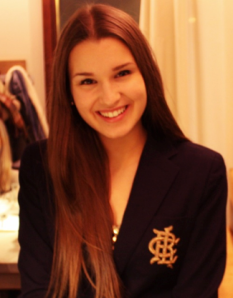
Nice to meet you! I am Maria Puolakkainen, an outgoing high school student from Helsinki, Finland. I am a dedicated student and my principle academic interests center around politics, economics, and philosophy. I am also passionate about languages; with English and Finnish as my first languages, I am fluent in French and am a beginner in Swedish and Italian. Making a difference in the student community is very important to me; I am the vice president of the Finnish International Baccalaureate Society (FIBS) and a member of the chairing board of the Finnish Upper Secondary School Student Union (SLL). As a passionate singer, dancer, and debater I try my best to balance between academics and extracurriculars.
Any questions? Contact me at
maria.puolakkainen@gmail.com
I am a seventeen year-old IB high school student in my penultimate year from Helsinki, Finland. Embodying a kind of bicultural identity, I am a product of two different cultural upbringings, Finnish and American. Having spent a few of my years of elementary school in Seattle, Washington, I have had the opportunity to reflect on the strengths and weaknesses of both school environments, and what effect they have had on me as a learner.
I feel honoured to have been invited by the PennFinn13 team to share my ideas and insight on education in Finland and the United States. As a result of pure serendipity on my half, I met the group a few weeks a go when they visited my calculus class on a Wednesday morning. I was able to participate in the Edutopia event held in Helsinki and get accquainted with the issues and points of interest of this project. Joe Mazza and the entire team were so warm to me and encouraged me to join the movement by contributing with a few blog posts. I truly value my school environment; to me it is like a safe harbour where I can feel respected, valued, and relaxed, learn, and mingle. Therefore, I am extremely interested in this project and hope to inspire people around the world to form these efficient and comfortable learning environments.
As a dedicated high school student, I demand a great deal from my teachers. I have often discussed the qualities of an effective teacher with my peers, and we have agreed that the importance of equality between teacher and student should be evident in many fields.
The stereotype of a Finnish teacher is built up with a master’s degree in teaching or one’s field, a calm and collected mindset, a relaxed teaching style, and above all, elevated expertise in one’s field. Many of my teachers do fit this mold, however it is unrealistic to imagine that each teacher will reach their degree of excellence with this pattern. In reality, the brilliances of different teachers lay on all different points of the spectrum.
When I sit back and evaluate from who I learn best from and what qualities does this teacher embody, I conclude in a set of features that I believe can be applied to any teacher-student relation for best results.
As I previously mentioned, the importance of respect and equality is crucial. Naturally the teacher is a superior authority figure in the classroom, but what I believe is the magic ingredient in this recipe is the humanization of the ’teacher figure’. By this I mean that he/she exhibits passion, dedication, and personal engagement in his/her teaching. If I feel that the teacher is truly passionate and excited about what is being taught, I am directly inspired by that joy of pursuing knowledge. I am certain we can all confirm that inspiration is contagious; listening to someone speak passionately on a topic with great expertise lights a peculiar glow inside us to learn and experience more in that field.
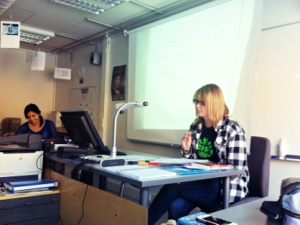
My classmate leads the English lit class as the teacher
has left us to converse openly on a given topic.
We must meet at halfway. As a student, I feel that the time and work I put into learning something is very valuable. The knowledge that the teacher is equally engaged on his/her work fulfills the first goal that I would like to emphasize. If I know that I am not the only one putting in my 110 percent, I am further inspired to apply myself even more. By demanding a lot from each other, both teacher and student are able to improve.
This translates to my next goal; fairness and equity. I believe that to teach well at this level, one must demand a great deal. Avoiding excessive lenience, or putting too much effort into ’being the student’s best friend’ can be counter-productive, and lead to discouragement in the student. Naturally excessive severity can be equally as discouraging: in this case humanizing the student comes into play. The fact that the teacher recognizes the workload and limits of students is very important. The value of the student’s mental and physical wellbeing must be emphasized, especially in rigorous academic programs. Setting demanding, yet fair deadlines and workloads is essential for maintained motivation and success in school. Students at my school also value clarity; being clear about what is demanded and how that can be achieved helps the student to visualize the work that needs to be done.
In addition, we all need a push; giving clear, honest, and useful feedback on how to develop is vital on the path of improvement. This should be naturally coupled with active encouragement. The degree of encouragement and belief in the students abilities directly correlates with academic performance. The value of encouragement and clear guidance is of utmost importance and I find that a teacher that shows light on the unknown path of success for the student is of my favorite kind. To quote Robert Frost;
’Two roads diverged in a wood,
and I,
I took the one less traveled by,
And that has made all the difference.’
The importance of compromise between ideal and real is very significant. It is equally quixotic to assume that each student is as motivated, driven, and talented as the next, as it is to imagine that each teacher fulfills my personal educator ideals. Each educator is a personality, a dynamic figure of unique variables, that flourishes in new, fascinating ways, and it is impossible to set identical goals for everyone. Often the element of surprise can be an even stronger initiative for learning. If there is a certain mystery between the nature of the teacher, it can inspire students to work hard in order to reveal more and more about that educational relationship.
In our world there are a range in varying school systems; from non-existant to high-perfoming, each is different and operates under the umbrella of different circumstances; financial, habitual, atmospherical, ideological, and political. I believe that the best we can do for any school system is to foster growth.
At my school, the teachers are always asking us how we can improve the class. By working together as a team and giving the students a voice in how they are treated and how things are handled in class is one of the reasons that the education system in Finland is so successful. Demonstrating genuine interest in what we, the students have to say, definitely has an impact on how interested we are in what the teachers have to teach us.
Three Is A Magic Number (In Any Language)
by Brandon Wiley
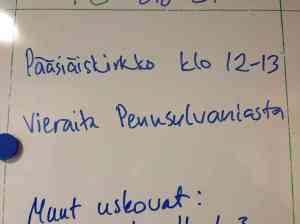
kolme…tre…trois…drei...three…
Whatever language you speak, the “magic number” when is comes to languages in Finland seemed to be three. That is, every student I spoke to shared that they speak at least three languages. Most usually, students were conversant in Finnish, Swedish and English. In addition, we found many students who could speak French, German, Russian and at one school, Latin was still an offering. I must admit that this wasn’t much of a surprise to me, as I have co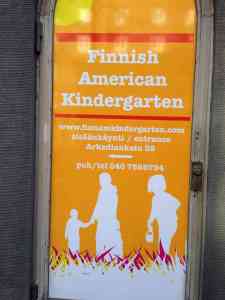 me to learn that many students outside of the United States develop fluency in multiple languages, especially throughout Europe. Throughout our conversations (in English, I might add), I tried to get a better understanding of why the acquisition of multiple languages seemed to be an important part of the Finnish education system.
me to learn that many students outside of the United States develop fluency in multiple languages, especially throughout Europe. Throughout our conversations (in English, I might add), I tried to get a better understanding of why the acquisition of multiple languages seemed to be an important part of the Finnish education system.
As part of the national core curriculum, a strong focus is placed on developing the “mother tongue” language skills and exploration of literature. Additionally, students are expected to focus on an A-language starting in grades 1 – 6 of compulsory education. A B-language is studied starting in grades 7-9. Often, English is taught during the early grades and is woven throughout coursework, with some classes taught exclusively in English. Despite the fact students do not start school until age 7, some families make an effort to begin this education prior to age 7. For example, we came across a ‘Finnish American” school that allows families to start students earlier than grade 1 and begins a focus on language acquisition at an early age.
Students seemed to understand the importance of learning multiple languages, especially English, and shared their views on the importance of learning different languages. Some of the perspectives shared were:
“We all need to learn English because it is the international language of business and law. It’s just necessary to learn it since it is used by so many countries, including, of course the United States.” – Grade 9 student
“I think it’s important for us to learn different languages so that we can be competitive and have an advantage in the future” – Grade 10 student
“Learning languages for me is really hard, but I think important. I want to travel some day and need to be able to speak to people.” – Primary student
“We incorporate world languages into our curriculum to help students understand the different cultures of the world. The curriculum is not simply to learn how to talk to others, but to better understand the way people live, work and think. Language is what binds us and connects us. But, if you aren’t fluent, it can also separate us.” – high school World Languages teacher
Understanding that the study and acquisition of languages plays a major role in the Finnish education system caused me to reflect on how this compares to the US system. Why does this matter? To my mind, it matters on two levels. First, I was once again struck by the Finnish emphasis on the “whole child” and providing a well-rounded curriculum and experience. In far too many American schools, world language is reserved for middle or high school coursework, with relatively few language immersion or early childhood language programs. In increasingly difficult economic times, more and more American schools are making cuts to world language programs or severely limiting the languages offered. It seems that it is more likely for U.S. schools to focus on helping students meet the minimum amount of language instruction necessary instead of thinking about how to maximize the number of languages students are fluent in before graduation. For a country as diverse and “cosmopolitan” as the United States, this stance seems very parochial and outdated. Through the study of languages, students engage in the study of cultures, customs and beliefs held by those different from themselves. Language instruction helps students develop a deeper understanding of diverse perspectives, history and expression. When students can master languages other than their native tongue, it opens a world of opportunities, helps overcome geographic and cultural barriers and generally makes interacting with others more enjoyable. In my last three trips outside of the United States, I did not speak the language of the host country I visited. I regret this and wonder how the experience could have been even richer had I been able to communicate authentically and fluently. In the spirit of developing the “whole child,” I wonder what would happen in the United States if language instruction was viewed as a “core content area?” (Answer: we’d probably test it to death.)
The second reason I think a focus on world language instruction matters is the competitive advantage it will give students in the 21st century. As graduates enter a highly competitive global world, they will be vying for admission to the same colleges/universities and applying for the same jobs. Even if all other things are equal, having limited language proficiency outside of English will be a competitive disadvantage for many American students. This focus on language instruction isn’t just happening in Finland. In a recent trip to China, I visited a school with over 5,000 students, all of whom were working hard to master their English speaking and writing skills. Their goal – attend U.S. colleges and universities beyond high school. Students around the world are developing language skills, yet the policy and funding in the United States seems to be lagging in this area.
As a side note, I’d like to give credit to our PennFinn13 colleagues, Jennifer, who spent several months leading up to our trip learning Finnish. She was an invaluable member of the team due to her ability to get us important information about bus schedules, menu options and basic interaction with the locals. However, we quickly learned that most everyone we encountered, whether in restaurants, grocery stores or on public transportation, spoke English extremely well. Jennifer spent time listening to podcasts in her car as she drove to/from work and longer excursions before departing for Helsinki. (Rumor has it that she could be seen talking to herself in Finnish at times!) Not only was her commitment to learning the language impressive, it made a real difference in our overall experience in the country. She has inspired me to study another language now and look forward to the challenge and benefit it will bring to my life. Stay tuned….
Have you ever seen Math Graffiti?
During our cross-cultural observations in Finland I welcomed the opportunity to visit math classrooms, interview several students and look through math textbooks. I noted small differences between three particular classes and teaching and learning I have observed in the United States.

Have you ever seen math graffiti? Taken from a street in Rovaniemi, Lapland. Translation: 9 years of primary school.
At Helsinki Normal Lyceum I observed seventh graders studying geometry, computing the volume of cones, rectangular solids and cylinders. The class began with informal conversation among students. The teacher then gathered the class attention by asking about difficulties with specific homework problems (from what I observed, the notion that there is no homework in Finland is a myth). The teacher took note of the confusing points. Then students completed the correct answers, on the board, to four illustrative problems. While students wrote on the chalkboard, the teacher circulated throughout the room, checking that other students had completed homework. She made marks in her grade book. Students were looking at their own and their table partner’s homework, and checking answers on the board. When done with the homework check, the class noted that one of the sample solutions on the board was incorrect and the teacher, through asking the class questions, walked through the correct solution.
Once homework review was complete, one student from each table pair picked up an I-pad. Students used Socrative software to compute and then report results for four different problems – results appeared projected from the LCD on the screen. Once done, the teacher assigned about twelve progressively more difficult area problems from the text. As an example the students had to calculate the area of a slanted cylinder, or half of a cylinder disguised as a suitcase with a handle. Students needed to re-think the shape and apply the formula and perform an additional calculation such as doubling or halving. Students worked in pairs. At the end of the work session the teacher asked the class for attention and students were assigned homework. Almost all students pulled out their Nokia phones, got up from their desks and took a picture of the assignment which was projected via the LCD.
This class in structure, presentation and topic varied little from a typical class I have observed in the U.S. However, two differences were noted:
Textbook: The textbook was about a quarter the thickness of your standard U.S. book, and there were only formulas and problems. That is it. No glossy photos, connections to careers, historical facts, no bright bolded sections, tabs, outlines of notes, no step-by-step tiered examples walking students through prescribed process explanations of how to do the math.
Student Affect: The students were motivated and worked. They sought each other out. They laughed, they talked at times while the teacher talked, they asked each other questions. The room felt very relaxed, and there was no tension, competition, control issues or discomfort between the teachers and/or the students. Two students shared with me that they often had time to work in class, and they would all get through most of the problems. He said that if they decided to talk to each other and be distracted it was their own responsibility. He said if they did not do the work then they did not learn.
At Helsingin Suomalainen Yhteiskoulu (HYK) I observed an International Baccalaureate (IB) calculus class that was taught in English. Students arrived in the classroom at the same time as the teacher (teachers in this school did not have set classrooms, they simply used a rooms for a particular class). The door shut and locked, the teacher turned on the document camera and asked the students which homework problems they had trouble solving using the product and quotient rule. Then teacher then sat at one desk, facing the board, as various students came forward to solve problems—both the teacher and other students asked questions about the solutions. In two of the problems the students had solved the problem in different ways and they discussed how you can simplify/solve various parts of the equation in a different order, but the solutions end up the same.
The teacher then launched into the lesson which was about finding the volume of an oil spill- using the chain rule and determining the change in the radius with respect to time. The textbook was the same text used by the AP (AB) calculus teacher(s) at my home High School in Jericho, Vermont. The structure of the class was not that different in terms of review of homework, new material, discussion, notes, and the homework assignment. One student arrived late with a quiet knock on the door, he quietly said, “Sorry I am late” and sat down.
The students appeared in total control of their learning. They ran the review of the homework problems, and when a student had a question during the teacher lecture portion of the class, (about the use of inverse, reciprocal and negative reciprocals within the context of the chain rule) the other students explained to her, moving form English to Finish. It was not just one student but four different individuals chimed in, watching the confused student’s body language, seeing her perplexed look at the explanation by one classmate and adjusting to Finnish when filling in the details to complete the understanding.
Questions: how much learning and teaching is directed by students as motivated independent thinkers? How much is controlled or directed by the teacher? How do we create a space and culture in our schools that promotes students taking complete ownership of their learning?
My third classroom visit was a fifth grade math classroom at Innokas Koulumestari—the teacher presented how he used technology in the class, and two students, using a powerpoint and smart board, showed us examples. Later two other students showed us lego robots they had built as part of their exploration. 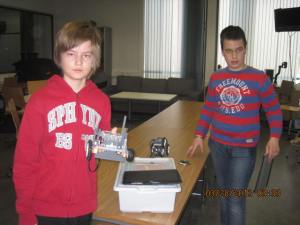
The learning was not divided into distinct content segments, but rather embedded. The teacher explained that there were also times when students received lessons and completed work from a workbook, but they did not do every assignment in the book. I took a moment to look through the math textbook sitting on the desk. First, the physical size of the book was considerably smaller than our Investigations books used at our elementary level. When I looked closer at the book, I noticed developmentally appropriate progressions in difficulty of the problems, and lots and lots of applications of fractions – number lines, pie charts and music. There were problems where musical notes illustrated and explained adding and subtracting. The teacher was a musician and he would use drum beats to teach fractions!
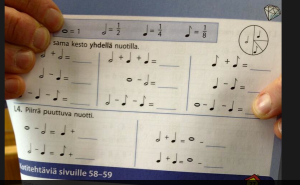 One can not make assumptions about math education in Finland based on these three observations; they merely provide a snapshot for reflections on teaching and learning in our own schools. In trying to summarize what was different, it occurred to me that what I was observing was the Common Core Standards for Mathematical Practice. In particular, students were: making sense of problems and persevering in solving them, constructing viable arguments and critique the reasoning of others, modeling with mathematics, looking for and making use of structure, and looking for and expressing regularity in repeated reasoning. The teacher, however, did not articulate the need or value in these standards of practice, it was simply a part of the learning.
One can not make assumptions about math education in Finland based on these three observations; they merely provide a snapshot for reflections on teaching and learning in our own schools. In trying to summarize what was different, it occurred to me that what I was observing was the Common Core Standards for Mathematical Practice. In particular, students were: making sense of problems and persevering in solving them, constructing viable arguments and critique the reasoning of others, modeling with mathematics, looking for and making use of structure, and looking for and expressing regularity in repeated reasoning. The teacher, however, did not articulate the need or value in these standards of practice, it was simply a part of the learning.
Actionable Items:
- Create school and classroom environments so that students own learning.
- Use multiple modes to teach math, bringing in interdisciplinary topics such as robotics, music and other applications.
- Allow for students to work through answers with each other, to answer each other’s questions, organically.
- Less is more: utilize math texts and resources that promote independent thinking and solving problems, not prescriptive lock-step methods.
- “Flip the classroom” supports some of the math learning I observed in Finland.
- Promote the notion of “80/20” — 80% of the time in the classroom the student is completing the work, 20% of the time the teacher is talking/presenting work. See Building School-based Teacher Learning Communities: Professional Strategies, By Milbrey W. McLaughlin and Joan E. Talbert.
On a final note, when I was walking on the streets of a small northern city in Lapland, I came across a section covered with graffiti. There was construction with plywood barriers and generators. On one particular generator there was a math problem, smiling face and peace symbol with the statement concerning nine years of primary school. What does this say about a culture when such pleasant graffiti, with correct math, mentions school?
